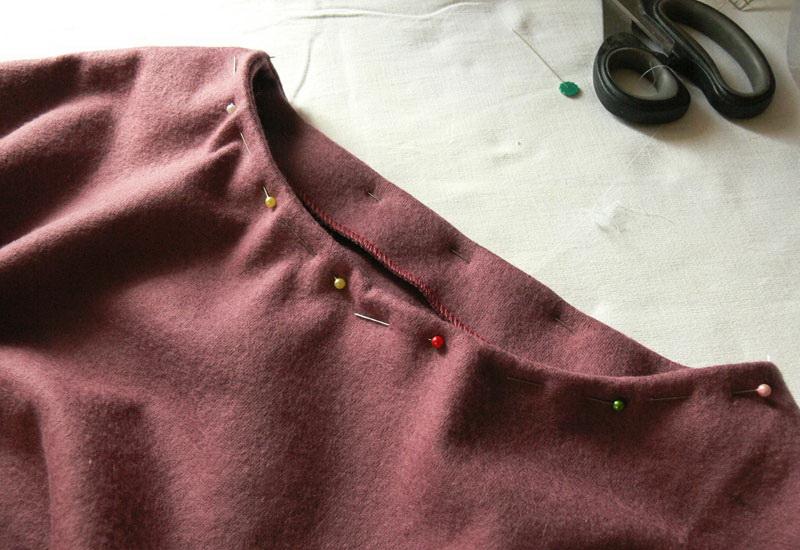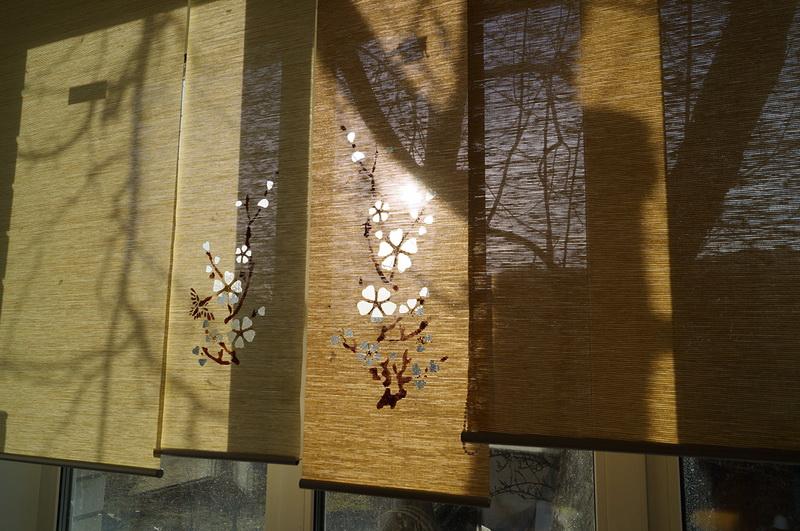Search the Community
Showing results for tags 'revamping'.
-
Wardrobe revamping: a dress with ‘bat’ sleeves A serger machine should not remain idle. Let’s use it to freshen up your old clothes and sew a knitted dress with ‘bat’ sleeves. In this tutorial, I’ll be employing simple dress sewing techniques: doing a blind hem on the serger and also attaching neckline facing. You’ll enjoy the work and the new dress will uplift your mood. To do this job, you’ll need: Fabric Sewing threads Serger and invisible stitch foot Adhesive sewing interfacing material for knits T-shirt or blouse pattern with 'bat' sleeves In order to buy the right amount of fabric, you need to know the length of your dress. Place the measuring tape at your shoulder and go all the way down (make sure that it is straight). Measure the desired length. The length of the piece of fabric will equal two lengths of the dress plus 20 cm. Wash or soak the fabric in hot water for approximately an hour. You need to do this in order for the fabric to shrink before you cut it. Skipping this step, you risk getting a smaller dress after the first washing. A dress with ‘bat’ sleeves. Cutting Fold the fabric in half, with its right side inside. Fold the T-shirt in half and align its fold line with the fold line of the fabric. Trace the outline with a piece of chalk. If you don’t have a blouse with ‘bat’ sleeves in your wardrobe, use a close-fitting T-shirt to find the key points, or a sewing pattern, changing the values to suit you. Having traced the outline and taking all basic measurements — chest, waist, and hips circumference — cut the back part with a 0.7 cm seam allowance. Place the cutout on top of the second piece of fabric, folded in half, and cut out the front part, making the front neckline approximately 3 cm deeper. Out of the remaining fabric, cut out a strip for the loops that will keep the belt in place. Sew, turn it right side out and press. Place the front and the back parts together, their right sides together. Position the belt loops at a waistline, over the side seams. Pin the side and shoulder edges, stitch the parts together on your serger with a 4-thread stitch. Attach the belt loops to the side seams. A dress with ‘bat’ sleeves. Facing Transfer the back and front neckline to the tracing paper, move down 3–4 cm down and cut out your future facing pattern. Glue the sewing interfacing material for knits to the piece of fabric. Cut out your front and back facing, together with seam allowance. Stitch the short sides together. Baste and finish the edge with a 3-thread stitch on your serger. Place the facing and the neckhole to each other, right sides together, and pin. Stitch with your serger, pin, and press lightly. Sew the facing to the neckline with invisible stitches. A dress with ‘bat’ sleeves. Hemming Mark the hemline on the right side of the fabric. Do the blind hem on your overlocker. You’ll know how to do that from our Blind hem with your serger tutorial (Link will be here in the future). Cut out the belt 11 cm wide (length should be equal to your waist circumference plus 3 cm). Attach the hooks, folding seam allowance inside. Your dress is now ready! Get your hair done, add some bijou and show off your new garment! Original text by Irina Lisitsa P.S. Sewing pattern
-
Cherry tree blossom: revamping old roller shades Roller shades have become a customary part of our homes. Thanks to the huge variety of textures and sizes, they can be easily adjusted to fit into our interior environments. And, should you make some changes to your interior design (I did), you can easily transform them, let’s say, by adding an oriental touch – a cherry tree blossom to remind you of the first rays of sunshine. For this tutorial, I’ll be using a design found on the Internet. I’ll alter it a bit, then cut it out using ScanNCut, and after that add some finishing touches with the help of a stencil. Materials Two pieces of roller shade material to fit your windows + fittings or two ready roller shades 30 cm wide. ScanNCut machine. Standard mat, 30 or 60 cm long, depending on the size of your design. A piece of paper large enough to fit your stencil. White craft glue. Fabric paints (I used acrylic). A sponge (or a paintbrush). A design. First, I made some changes to the picture I found (a cherry tree branch) in Canvas Workspace (the former ScаnNCutCanvas). You’ll need 2 files, one for making a stencil, and another one for cutting the roller shade. Open the image in your Canvas Workspace, go to Image Tracing, and press Color–Preview–OK. Select all objects, right-click and press Group. Save the result to a USB flash drive. This is our file No1. We’ll use it to create a stencil. Now, we proceed to the pattern for the shade. We’ll only need those objects that are going to be cut. Select all stems on the image and press Delete. Only the flowers should be left. This is our file No2. We’ll use it to cut the roller shade. Select all objects, right-click and press Group. Save the result to USB flash drive. (In order for the patterns on the shades to differ slightly, I deleted several flowers on the bottom and saved them into a separate file). Let’s prepare our roller shades. I cut 30 cm from each piece of fabric, thus getting two shades 30 cm wide (because my cutting mat is 30 cm wide). Metallic tubes on top and bottom of every shade should be filed with a mill file. Slide the bottom hem of the shade from the metal tube and detach the cardboard strip. Or, you may use a couple of existing roller shades, 30 cm wide each. In that case, you’ll only need to de-tube them and remove the strips. Secure the bottom edge of the shade to the mat and do the test cut. (Blade length 5, pressure 4. Other values may be used, depending on the material your roller shade is made of). Open file No2 in ScanNCut. Now let’s alter the design a bit: first invert it, then check the size and placement. Cut out your pattern and unpeel it from the mat. Repeat with the second roller shade. Change the size and placement of the design and cut. Apply some white craft glue to the wrong side of the narrow parts to give them additional strength. After the glue dries, it won’t be visible. Cut out a paper stencil, using file No1. Blade length 4, pressure 0. Align your stencil with the pattern on the shade and secure it with pieces of an adhesive tape. To be on the safe side, I also taped over the flowers, to prevent the paint from getting there. Squeeze the paint onto the paper, dip your paintbrush/sponge into it and start tapping on the openings in the stencil. It will take approximately 5 hours for the paint to dry. After that, take away your stencil, attach strips of cardboard to the bottom parts of the shades and insert metallic tubes. Attach fittings to the narrow shades and put them up. Hopefully, this will add a bit of sunshine into your winter homes. The idea for the decoration in this tutorial was found on the Internet. Original text by Maria Bespalova





